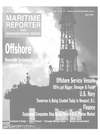
Spanish Group Endorses Pentamaran
As part of its strategy to foster business in the high-speed marine transportation sector, Spain's IZAR Group is collaborating with the British technical consultancy Nigel Gee & Associates (NGA) in the development of fast RoPax and RoRo vessel designs.
The recent unveiling of a proposal for a 40-knot RoPax type followed the signing of a license agreement granting IZAR exclusive European manufacturing rights to the adoption of the Pentamaran hull form in large RoRo equipped vessel applications.
The pact gives a further string to IZAR's bow in its multi-faceted bid to re-enter the high-speed ferry market. It also provides a basis whereby the innovative, patented Pentamaran could be pro- gressed from a widely-acclaimed concept to forming the template for a range of vessels to be introduced to the market over the next five years.
IZAR has substantial experience in the design and construction of light-displacement fast ferries, built at its San Fernando yard. Market studies car- ried out by the group pointed to a future demand for vessels of up to 40 knots incorporating higher deadweights than previously possible, with shipowners seeking 1,000-dwt and looking longerterm to 2,000-dwt or more.
Rather than scaling-up existing monohull types for such combinations of speed and higher payloads. IZAR sought alternative, more cost-attractive solutions.
The Pentamaran form, a slender monohull stabilized by two pairs of sponsons resulting in a broad loading platform, was favored for the potential it offers for a 30 percent reduction in power in large, high-speed vessels relative to current monohull or catamaran alternatives. The Pentamaran RoPax proposal, moreover, employs steel construction and heavy fuel oil-burning medium-speed diesel plant, out of consideration of owners' preferences and operating cost criteria.
In a paper prepared for the recent Fast Ferry Conference in Nice by Juan Antonio Moret, IZAR's high-speed vessel design manager, and Nigel Gee, managing director of Southamptonbased NGA, it was explained that the IZAR Pentamaran fast ferry had been developed to carry 900 passengers and 280 cars, or up to 24 x 30-ton trucks plus 48 cars.
While formulated in mind of a wide range of potential route applications, special reference had been made in the project development to the conditions and requirements on two busy connections, the 20-mile route across the Gibraltar Strait between Algeciras and Ceuta. and the 120-mile link between Barcelona and Palma di Mallorca.
Propulsion machinery would be installed in the central hull just aft of midships. Four engines of the Wartsilii 38-series medium-speed design have been built into the provisional specification.
driving a total of three transommounted, steerable and reversible waterjets.
The configuration is intended to yield the requisite raw power and maneuverability, while also conferring flexibility and economy by better enabling engine usage and settings to be closely matched to actual service and speed requirements.
IZAR is also cooperating with NGA in the development of a larger Pentamaran design for carrying up to 3,000-tons of RoRo cargo in open-sea conditions. This would have a top speed of 41-knots, engendered by a medium-speed diesel plant, and be fabricated from high-tensile steel throughout.
Other stories from April 2002 issue
Content
- U.S., Spain Team To Develop New Warship page: 4
- Bennis to Lead Maritime, Land Security page: 4
- Halmatic To Supply RIBs For Maritime & Coastguard Agency page: 8
- Germanischer Lloyd Reorganizes Operations page: 11
- Celebrity Cancels Summit And Infinity Sailings page: 11
- Kvaerner And Aker Maritime Join Forces page: 12
- Royal Caribbean And Celebrity Announce Key Appointments page: 13
- Key Port Security Measure Passed page: 16
- Boston Whaler Unveils "Robot" Security Boat page: 18
- Protection Zones In Place For USS Roosevelt's Return page: 19
- DOT Outlines Smart Card Concept For Transportation Workers page: 20
- I MO Calls for Unity on Bulk Carrier Safety page: 22
- OECD Working Group To Brainstorm on Port Security page: 22
- NWDC: The Ultimate One-Stog Shop page: 24
- Boston Whaler Debuts New Security Products page: 26
- No Substitute for A Strong Navy page: 28
- HSV Gets Marines There Faster page: 33
- Information: The Real Power page: 33
- GE Continues To Set Gas Turbine Tech Pace page: 34
- Vericor Is A Reliable Source of Propulsion Power page: 35
- The Allure of Power page: 36
- Spanish Group Endorses Pentamaran page: 37
- industrial Heritage Is Retained page: 38
- MES Completes the World's Largest Diesel Engine page: 39
- Faster Than A Speeding... page: 40
- The Rolls-Royce Design Solution page: 41
- Jane Tide Makes An Impact page: 41
- Halliburton Brings Viking To GOM page: 42
- ABS Speeds Truss Spar Projects to GOM page: 42
- Bollinger Signs Contract For Supply Boat Trio page: 43
- As Banks Step Down, Equipment Finance Companies Step Up page: 44
- Cummins Inc. And CitiCapital Launch Alliance page: 46
- ACR — On The Road To Safety And Survival Technology page: 48
- New Service Frees Ships From Hostile Situations page: 49
- Positive Outlook for Global Subsea Development, Deepwater Strengthening page: 50
- A World of Controversy page: 64
- INTERTANKO Holds Firm Position o n M a r i t i m e security page: 66
- North Mariner — In A Class of Its Own page: 68
- Volvo Penta Engines In Clean Design Ferry page: 69
- Hernis 400 System Is Safe And Sound page: 69
- The Dash for Gas page: 74
- BP's Discovery Is Re-Named Thunder Horse page: 75
- Crowley Moves ExxonMobil Concrete Island Drilling page: 76
- Dresser-Rand Equips Petrobras FPSO page: 76
- Transas Launches LNG Tanker Simulator page: 76

